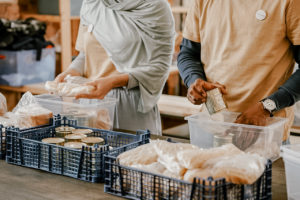Intersectional environmentalism is a conceptual framework which serves as a valuable tool to help us better understand the roots and impacts of environmental injustice. In fact, the nuanced insight offered to us by intersectionality is essential if we wish to move towards a more truly equitable world, as given the complexity of our modern political and social environments, the true consequences of our actions and systems are often obscured.
For example, in our pre-industrial society, the purchase of a tomato took place in a relatively limited sphere. Tomatoes grown using nutrients from the land were usually transported a relatively short distance, were bought either from the farmer or somebody working for the farmer, and then eaten by the first purchaser.

Today, however, our modern systems are infinitely more complex, and the same transaction will involve producers of farm machinery, chemical fertilizer companies, fuel companies, transport companies, migrant workers, packaging companies and disposal companies. This enormous web of interconnection makes it difficult for us to track the full impact of our political and social actions. This complexity also makes it hard for us to understand how our political and productive systems impact individuals.
Intersectional environmentalism, and intersectionality as a whole, help us to better understand the social and environmental impacts on people from a very wide range of backgrounds; many of whom might otherwise have their needs overlooked or marginalized. This helps us to create more meaningful, holistic solutions within the sphere of environmentalism.
In order to explain this complicated topic, this article will first explore what intersectionality is, and how it can be used, before examining environmental intersectionality and exploring the consequences of environmental intersectionality within the zero-waste movement.
What is intersectionality?
Intersectionality is a critical tool and evaluative framework which describes the way in which the intersecting identities of individuals can make them subject to several compounded forms of injustice, creating forms of injustice and oppression which are unique to specific individuals and groups. This leaves those individuals vulnerable to having their needs overlooked as larger groups, of which they are a part, work towards justice.

The term was coined in 1989 by Kimberlé Crenshaw and was used to describe the experience of Black women in the US, particularly in the context of feminism and the civil rights movement during the 1960s. Crenshaw demonstrated how the intersection of their Blackness and their womanhood led to compounded discrimination and oversight—as Black people, their needs were marginalized within the feminist movement; as women, their needs were marginalized within the civil rights movement.
Their intersecting identities, along with those of many other individuals who belong to several oppressed groups, created a compounded form of oppression in which their needs were either overlooked, or were actively discriminated against, even within the very movements which sought to address oppression. These women were subjected to racism within the feminist movement and misogyny within the civil rights movement. Yet as the nature of this process was the marginalization of their experience, without the attention and practice of intersectionality, these practices had the potential to grow.
Intersectional justice, therefore, seeks to create more space for and awareness of those whose intersecting identities make them subject to compounded forms of injustice. Doing so enables their political enfranchisement and creates space for their needs to be more identified and met.
This process can be achieved by seeking to understand the impact of intersecting identities, and by examining how a given set of identity characteristics, such as race, class, gender, sexual orientation, or language, can impact the presentation and representation of individuals within another group.
What is intersectional environmentalism?
Intersectional environmentalism is based upon the awareness that environmental injustice does not affect all people equally, but rather that it tends to have the greatest impact on those who suffer from other forms of social injustice. For example, within the US, it is generally “minority” groups such as Black communities and indigenous communities, who have been subject to discrimination for generations, who are most effected by negative environmental consequences. This is known as environmental racism.
Environmental racism shows up in many ways. For example, due to the allocation of resources and zoning laws, it is generally BIPOC communities within the US who are most closely situated next to environmentally degraded or degrading sites. However, they are also often the least equipped to deal with the negative effects of environmental degradation.

It is also true that indigenous communities are especially impacted by environmental degradation. Many indigenous groups are culturally inclined to live using ecologically sustainable practices, as they are more closely reliant on a stable ecology for their livelihood and wellbeing than people living in economically developed regions. Subsequently, their environmental impact is very low. However, their reliance on a stable ecology leaves them especially vulnerable, as relatively small changes in temperature, soil quality or the availability of water can have a dramatic impact on their livelihood.
However, due to their position as a “marginal” community, their needs are often neglected when it comes to the development of solutions to the climate crisis. Whilst hydroelectric power might seem like an excellent source of clean energy for those living in cities, the construction of a dam can cause dramatic ecological changes, which include flooding and the relocation or erasure of fisheries. These might be marginal issues for city dwellers, but they are changes which can uproot entire indigenous communities.
It is essential for the intersectional environmentalist to understand that the climate crisis will not affect all people equally, and that if we wish to make equitable change, we need to ensure that marginalized groups are actively involved in the development of climate solutions.
If they are not, then any solutions are bound to favor the needs of those with political power. The political activist Leah Thomas said that inclusive environmentalism must identify “the ways in which injustices happening to marginalized communities and the earth are the most interconnected”. It is only by ensuring that those communities are heard that we can introduce true intersectional environmental justice.
Environmental intersectionality in the zero-waste movement
In order to ensure that our attempts to develop systems of justice are equitable, we must turn to intersectionality for guidance. This is as true for the zero-waste movement as it is for any other.
There have been many criticisms leveled at the environmental justice space in general, and at the zero-waste movement in particular, which raise the concern that these movements are overly tailored toward white members of the middle class.

This is certainly easy to understand, as many people initially encounter the zero-waste movement as a way to reassess the way we consume at home. This can be seen in guidance to buy in bulk and from zero-waste stores; in buying organic food from close to its source; from the purchase of new, zero-waste containers, beeswax food wraps and refillable product bottles.
These are undoubtedly valuable practices which help to reduce waste and encourage mindful interaction with our systems of production. However, each of these choices presume a degree of privilege; of the financial freedom to buy new products and to buy in bulk; of access to fresh food nearby; and of a lack of more immediate environmental concerns which require more direct action.
Yet these are forms of privilege are often not available to those who live in environmentally degraded communities. For example, most of the landfill and incineration sites in the US have been built in proximity to Black communities, which have suffered from years of racist investment practices. Clearly, buying in bulk and reusing containers may help to mitigate the quantity of waste landfilled, but this practice may be financially unavailable to members of those communities, and does little to mitigate the immediate health risks.
As such, intersectionality in the zero-waste movement serves to ensure that the movement works to meet the needs of people in all environments, with a focus on those who are subject to all forms of social injustice. This means, for example, working to help members of those communities develop local food networks, rather than focusing solely on our consumption of single-use packaging—taking immediate action to reduce the negative impact that our current system of production has on the most politically vulnerable. Most importantly, it means turning to underrepresented and underprivileged groups for guidance and leadership, so that we can push towards truly equitable change.
For more information on the Zero Waste movement, and how it can be used to make meaningful change, check out the Zero Waste website. It is full of ideas for how to make our business and communities more equitable for all.

